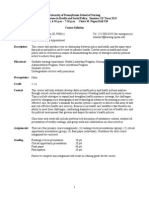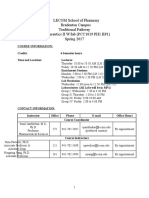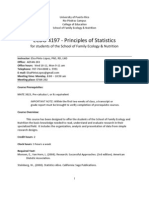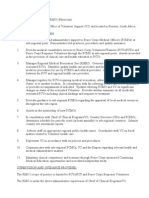Services/148/documents/medical Terminology Standards Aug 2014 PDF
Services/148/documents/medical Terminology Standards Aug 2014 PDF
Uploaded by
api-326287942Copyright:
Available Formats
Services/148/documents/medical Terminology Standards Aug 2014 PDF
Services/148/documents/medical Terminology Standards Aug 2014 PDF
Uploaded by
api-326287942Original Title
Copyright
Available Formats
Share this document
Did you find this document useful?
Is this content inappropriate?
Copyright:
Available Formats
Services/148/documents/medical Terminology Standards Aug 2014 PDF
Services/148/documents/medical Terminology Standards Aug 2014 PDF
Uploaded by
api-326287942Copyright:
Available Formats
HSI, 1
Course Syllabus
2015- 2016
TEACHER: Kellie
Flowers, RN
COURSE: Medical Terminology (5540)
EMAIL: kellie.flowers@darlingtoin.k12.sc.us
PHONE: 843-398-3250
EXTRA HELP TIMES: 7:45 8:10 am Monday, Wednesday, & Friday; other times
by
appointment only (24-hour notice please)
COURSE DESCRIPTION:
Credit: 1 unit
Medical Terminology is designed to develop a working knowledge of the language of
health professions. Students acquire word-building skills by learning prefixes,
suffixes, roots, combining forms, and abbreviations. Utilizing a body systems
approach, students will define, interpret, and pronounce medical terms relating to
structure and function, pathology, diagnosis, clinical procedures, and pharmacology.
Students will use problem-solving techniques to assist in developing an
understanding of course concepts.
STANDARDS/COURSE GOALS:
Students are expected to meet the Medical Terminology Standards, as outlined by
the South Carolina Department of Education, which are based on the National
Health Care Standards. The SC Department of Education Medical Terminology
Standards may be viewed at
http://ed.sc.gov/scdoe/assets/file/programsservices/148/documents/Medical_Terminology_Standards_Aug_2014.pdf
MEDICAL TERMINOLOGY
Medical terminology standards focus on body systems, to include the following:
Skeletal
Urinary
Muscular
Nervous
Cardiovascular
Special Senses: Eyes and Ears
Lymphatic and Immune
Integumentary
Respiratory
Endocrine
Digestive
Reproductive
HSI, 2
Foundation Standard 1: Academic Foundation
Healthcare professionals will know the academic subject matter required
for proficiency within their area. They will use this knowledge as needed in
their role. The following accountability criteria are considered essential for
students in a health science program of study.
Human Structure and Function
1. Classify the basic structural and functional organization of the human body
(tissue, organ, and system).
2. Recognize body planes, directional terms, quadrants, and cavities.
3. Analyze the basic structure and function of the human body.
Diseases and Disorders
4. Describe common diseases and disorders of each body system (prevention,
pathology, diagnosis, and treatment).
5. Recognize emerging diseases and disorders.
6. Investigate biomedical therapies as they relate to the prevention, pathology, and
treatment of disease.
Foundation Standard 2: Communications
Healthcare professionals will know the various methods of giving and
obtaining information. They will communicate effectively, both orally and
in writing.
Medical Terminology
1. Construct medical terms using prefixes, suffixes, roots, and combining forms.
2. Use appropriate medical terms to communicate information.
3. Identify medical abbreviations to communicate information.
4. Determine definition of a medical term by examining its component word parts.
Concepts of Effective Communication
5. Pronounce medical terms.
6. Apply speaking and active listening skills.
7. Interpret verbal communication.
Written Communication Skills
8. Recognize elements of written and electronic communication (with emphasis on
correct spelling, grammar, and formatting).
9. Use medical dictionaries and multimedia resources to interpret medical
terminology.
MAJOR ASSESSMENT AND GRADING PRACTICES:
Final Grades:
Nine Weeks:
First Nine Weeks
Second Nine Weeks
Third Nine Weeks
Fourth Nine Weeks
Final Exam
Class work & Homework
Quizzes
Tests/Projects
20%
20%
20%
20%
20%
25%
25%
50%
HSI, 3
Darlington County School District Grading Scale:
90 80 70 60 0-
100
89
79
69
59
A ~ Exceeds expectations
B ~ Meets Health Science standards & expectations
C ~ Passing grade but does not meet some standards
D ~ Passing, but only meets minimum standards
F ~ Failing, does not meet minimum standards
*This is in conjunction with the South Carolina Uniform Grading Scale. Numerical
grades will be reported on interim reports and report cards
MAJOR COURSE ASSIGNMENTS & PROJECTS:
Tests: Unit tests will be administered at the completion of every unit. Cumulative
mid-term and final exams will be administered as scheduled by Darlington County
Institute of Technology.
Projects: Students will complete many projects and assignments throughout the
semester. Project guidelines, requirements, and due dates will be discussed when
the project is assigned. A few assignments are included in this syllabus for your
review; other assignments will be given in class.
#1 ~ Current Health/Medical Event Paper (two part project ~ Weekly Quiz
Grade)
PART 1 (due Friday of 2nd, 4th, 6th, and 8th weeks of the quarter)
The current event will include a 50 word or greater report that includes a summary (in the
students own wordsplagiarism will receive a zero quiz grade) and the students
developed opinion, and documentation of the source utilized. (See additional handout for
grading criteria.) The health/medical article must come from
USA Today
CBS News Healthwatch http://www.cbsnews.com click on Health
PART 2 (due Friday of 3rd, 5th, 7, and 9th weeks of quarter)
Student should reply/ respond to two posts made by a classmate the previous week
Response should include students well thought out opinion of classmates original post
Can not just agree or disagree must explain why
Does not need to be more than a few sentences.
#2 ~ Unit Video Group Project (Test Grade)
Groups will make a video to be shared with the class to teach an assigned
medical terminology chapter. Rubric will be given for students to go by.
HSI, 4
REQUIRED READINGS AND MATERIALS:
Myrna Lafleur Brooks, Exploring Medical Language. St. Louis, Missouri:
Mosby Elsevier, latest edition
Health Center 21: Health Care Foundations Computer-based health
science curriculum
Materials: Notebook (3 ring binder, or 3-prong folder with pockets), pencils, black
or blue pens, notebook paper and white printer paper for printing notes, earphones,
4x6 index cards, markers or colored pencils, and other supplies for projects as
needed
EXTRA HELP OPPORTUNITIES:
There is no shame in asking for or receiving extra help to promote understanding
and development of skills. Students are encouraged to seek extra help from their
peers, their teacher, or others who have the knowledge or skill to assist. Teachers
will post times they are available before, during or after the school day, as well as
ways they may be accessed through communicate that additional help is needed.
BEHAVIOR PLAN:
Please pay close attention to rules and procedures (see procedures and
expectations letter) to ensure your safety and the safety of those around you. We
will participate in many hands-on activities that will require you to follow safety
measures. In the case of behavior and discipline problems, I will follow the DCIT and
district policy related to the offense and make referrals to administration as needed.
WISH LIST:
Kleenex
Glue Sticks
Markers
Construction paper
Cleaning wipes/ baby wipes
Scissors
Hand Sanitizer
Papertowels
HSI, 5
You might also like
- Epidemiology in Public HealthDocument10 pagesEpidemiology in Public HealthNorbel Tabo100% (1)
- N 540 Health PolicyDocument7 pagesN 540 Health Policyapi-267840127No ratings yet
- rx403 Case Studies Syllabus Fall 2020 Oct 2 2020Document9 pagesrx403 Case Studies Syllabus Fall 2020 Oct 2 2020api-534214500No ratings yet
- HPA 465 Syllabus SummerDocument12 pagesHPA 465 Syllabus Summershanelbbdo0% (1)
- The Timing of Orthodontic TreatmentDocument8 pagesThe Timing of Orthodontic TreatmentcareNo ratings yet
- Med-Surg Nursing NotesDocument232 pagesMed-Surg Nursing NotesMaria100% (5)
- Nur 302 Health AssessmentDocument4 pagesNur 302 Health AssessmentCandy YipNo ratings yet
- Nurs2105td Int 2008Document12 pagesNurs2105td Int 2008api-3703791100% (2)
- A Sylllamlbu That Io LadkitoDocument4 pagesA Sylllamlbu That Io LadkitoBrizzy DalnaNo ratings yet
- Epidemiology 500Document186 pagesEpidemiology 500Ridwan SulaimanNo ratings yet
- NURS 5100 Pharmacotherapeutics (Weinreich)Document10 pagesNURS 5100 Pharmacotherapeutics (Weinreich)dawnNo ratings yet
- GHP557 - Fundamentals of Global Health - Syllabus - 28aug2021 - FinalDocument32 pagesGHP557 - Fundamentals of Global Health - Syllabus - 28aug2021 - Finalps.harsha2004No ratings yet
- Department of Clinical Sciences Course Name: MD - 5 Student SyllabusDocument8 pagesDepartment of Clinical Sciences Course Name: MD - 5 Student Syllabustamara689No ratings yet
- SPH 711 Syllabus Fall 2021 FINAL 08.24.21Document9 pagesSPH 711 Syllabus Fall 2021 FINAL 08.24.21charlottehbs91No ratings yet
- Core Knowledge For Practice COMDocument197 pagesCore Knowledge For Practice COM2020m002No ratings yet
- Norvella SyllabusDocument16 pagesNorvella Syllabusapi-282155149No ratings yet
- Pm64@hunter - Cuny.edu: and Its Impact On The HIV EpidemicDocument10 pagesPm64@hunter - Cuny.edu: and Its Impact On The HIV EpidemicTenzing Ten JapheNo ratings yet
- DONE - EPIDEM 2110 Principles of EpidemiologyDocument9 pagesDONE - EPIDEM 2110 Principles of Epidemiologyanibiris12No ratings yet
- Medical Sociology Course OutlineDocument9 pagesMedical Sociology Course OutlineKandii KoutaraNo ratings yet
- Nursing Management and Leadership Syllabus4Document7 pagesNursing Management and Leadership Syllabus4Jane TuazonNo ratings yet
- Pharmaceutics II. PCC 1019 Syllabus 2017Document12 pagesPharmaceutics II. PCC 1019 Syllabus 2017hoaivan5199351993No ratings yet
- NAAC 2Document4 pagesNAAC 2yendluripradeepkumarNo ratings yet
- 1-PHPM 574 Public Health Policy Management - 2019 - FallDocument14 pages1-PHPM 574 Public Health Policy Management - 2019 - FallAla Abo RajabNo ratings yet
- Diana Barnett Course Critique n5327 RDocument4 pagesDiana Barnett Course Critique n5327 Rapi-308950624No ratings yet
- Formatif FeedbackDocument4 pagesFormatif FeedbackKhoirul Ahmada PutraNo ratings yet
- SOCW 552 SyllabusDocument8 pagesSOCW 552 SyllabusAndrew BrazzaleNo ratings yet
- University of Massachusetts, Amherst College of Nursing NUR 398F, Nursing Care of Children: Practicum Well Child School ExperienceDocument3 pagesUniversity of Massachusetts, Amherst College of Nursing NUR 398F, Nursing Care of Children: Practicum Well Child School ExperienceNemil PerezNo ratings yet
- Goals & Objectives: I. Patient CareDocument4 pagesGoals & Objectives: I. Patient CareBhawna PandhuNo ratings yet
- +surgery III (Urology, Traumatology & Orthopedics)Document7 pages+surgery III (Urology, Traumatology & Orthopedics)4pm6gjq78cNo ratings yet
- Week4 WikikDocument8 pagesWeek4 Wikikapi-294721909No ratings yet
- Guidebook MEDDocument8 pagesGuidebook MEDdoctordilafrozaNo ratings yet
- I Dex 302 Medical Miracles Medical ExplorerDocument10 pagesI Dex 302 Medical Miracles Medical ExplorerakritiNo ratings yet
- Fmcurriculum (v3)Document18 pagesFmcurriculum (v3)jb cookiesNo ratings yet
- Research Methodology Lecture NotesDocument80 pagesResearch Methodology Lecture Noteschelsea pasiah100% (2)
- MD Curriculum in Gen - Med in Competency Mode-FinalDocument35 pagesMD Curriculum in Gen - Med in Competency Mode-FinaldrtpkNo ratings yet
- Social Issues Fall 2016Document7 pagesSocial Issues Fall 2016emeraldwxyzNo ratings yet
- HCS 212 - Course Syllabus UpdatedDocument10 pagesHCS 212 - Course Syllabus UpdatedNicole LeoNo ratings yet
- Hpeb 553 Fall 2021 07-24-2021 1Document9 pagesHpeb 553 Fall 2021 07-24-2021 1api-661484626No ratings yet
- Sgu CompendiumDocument44 pagesSgu Compendiumdudeman2332No ratings yet
- NURS223 02 Course OutlineDocument18 pagesNURS223 02 Course Outlinex5kvnbspsy100% (1)
- Psych Clinical Rotation EvaluationDocument3 pagesPsych Clinical Rotation Evaluationapi-740251080No ratings yet
- SCP V Log BookDocument58 pagesSCP V Log BookRameen RizviNo ratings yet
- Health10 q4 Week6 v4Document12 pagesHealth10 q4 Week6 v4Maria Rose Tariga AquinoNo ratings yet
- Joiner Technology Lesson Plan-IsTE - Spring 2018Document13 pagesJoiner Technology Lesson Plan-IsTE - Spring 2018Jennifer JoinerNo ratings yet
- Course CompetenciesDocument2 pagesCourse Competenciesapi-282588641No ratings yet
- DNB Pediatrics, CurriuculumDocument44 pagesDNB Pediatrics, Curriuculumbalasubramanian iyer100% (1)
- COMS 2601 Course Outline Sem II 2023-24Document5 pagesCOMS 2601 Course Outline Sem II 2023-24lexiannabethNo ratings yet
- Clinical Teaching PlanDocument5 pagesClinical Teaching Planapi-258524831100% (1)
- Clinical Skills Resource HandbookDocument89 pagesClinical Skills Resource Handbookanggita budi wahyono100% (1)
- Syllabus ECDO 4197 - Principles of StatisticsDocument8 pagesSyllabus ECDO 4197 - Principles of StatisticsOEAENo ratings yet
- +research Skills IVDocument7 pages+research Skills IV4pm6gjq78cNo ratings yet
- Course Syllabus & Schedule - January 17, 2018Document8 pagesCourse Syllabus & Schedule - January 17, 2018Rahman AkinlusiNo ratings yet
- Haytbayev PortfolioDocument14 pagesHaytbayev PortfolioUzbek star vlogsNo ratings yet
- Soc 8090 Topics: Sociology of Health and IllnessDocument13 pagesSoc 8090 Topics: Sociology of Health and IllnessMarcin SernikNo ratings yet
- PHAR505 SyllabusDocument14 pagesPHAR505 SyllabusshopgurlNo ratings yet
- Paediatrics PDFDocument44 pagesPaediatrics PDFNeha OberoiNo ratings yet
- Competency Based Training Programme: Guidelines ForDocument42 pagesCompetency Based Training Programme: Guidelines ForPrithwiraj MaitiNo ratings yet
- GMHA 601 - X1 Syllabus FA24Document9 pagesGMHA 601 - X1 Syllabus FA24Didier Augusto Cardona VillalobosNo ratings yet
- BIO250Micro Nursing PDFDocument7 pagesBIO250Micro Nursing PDFrevathidadam55555No ratings yet
- Medical TechnologyDocument9 pagesMedical TechnologyAly Bint Smbs50% (2)
- Medical Terminology Study Guide: The Complete Study Guide to Easily Understand, Pronounce and Memorize Medical TermsFrom EverandMedical Terminology Study Guide: The Complete Study Guide to Easily Understand, Pronounce and Memorize Medical TermsNo ratings yet
- Cebu Institute of Technology - University College of NursingDocument2 pagesCebu Institute of Technology - University College of NursingSergi Lee OrateNo ratings yet
- Ucm 307643 PDFDocument2 pagesUcm 307643 PDFMichiel Angelo Albaladejo PerojaNo ratings yet
- 05 Lifting and Moving PatientsDocument48 pages05 Lifting and Moving PatientsYunita Evi Indrani100% (1)
- Effect of Temperature On The Vector Efficiency of Aedes Aegypty For Dengue 2 VirusDocument10 pagesEffect of Temperature On The Vector Efficiency of Aedes Aegypty For Dengue 2 VirusEndi VillalobosNo ratings yet
- TheWallStreetJournal 20241104Document34 pagesTheWallStreetJournal 20241104lautaro.ortiz69No ratings yet
- Building Quality-Assured Manufacturing Capacity in Nigeria - WHO Prequalification.Document6 pagesBuilding Quality-Assured Manufacturing Capacity in Nigeria - WHO Prequalification.Henry KayNo ratings yet
- SOP For Patient Consent 2024Document32 pagesSOP For Patient Consent 2024fireboltv47No ratings yet
- Orthomed Catalogue FullDocument468 pagesOrthomed Catalogue FullMinh ChíNo ratings yet
- Baseline 7 Piece Hand Evaluation SetDocument8 pagesBaseline 7 Piece Hand Evaluation SetphcproductsNo ratings yet
- Tu-Getexam2540 PDFDocument60 pagesTu-Getexam2540 PDFppppNo ratings yet
- 11 Farmakokinetika Klinik Antibiotika Aminoglikosida PDFDocument19 pages11 Farmakokinetika Klinik Antibiotika Aminoglikosida PDFIrfanSektionoNo ratings yet
- Pharmacodymics and Toxicodynamics 21 - 09 - 15Document60 pagesPharmacodymics and Toxicodynamics 21 - 09 - 15AubreyNo ratings yet
- Trauma WajahDocument37 pagesTrauma WajahMuhamad Agung SupriyantoNo ratings yet
- Vocab Unit 6Document2 pagesVocab Unit 6Firery casiniNo ratings yet
- 2009 CMT Curriculum (Amendment 2013)Document181 pages2009 CMT Curriculum (Amendment 2013)Mohammed BashaNo ratings yet
- ApplicationDocument3 pagesApplicationDinesh KhoodyNo ratings yet
- USCE Database Compiled by Usmlesarthi TeamDocument12 pagesUSCE Database Compiled by Usmlesarthi Teamagar agarNo ratings yet
- 564251KYDocument20 pages564251KYSudharsanaveediappan EthirajanNo ratings yet
- Peace Corps Regional Medical Officer Statement of WorkDocument1 pagePeace Corps Regional Medical Officer Statement of WorkAccessible Journal Media: Peace Corps DocumentsNo ratings yet
- Pharmacy PresentationDocument93 pagesPharmacy PresentationAira Abella100% (1)
- Research On Institutional Policies and Guidelines On Safe Drug Administration and Interprofessional PracticeDocument2 pagesResearch On Institutional Policies and Guidelines On Safe Drug Administration and Interprofessional PracticeCyrus NadaNo ratings yet
- Liver, Pancreas and Biliary Tract Problems: Case StudyDocument62 pagesLiver, Pancreas and Biliary Tract Problems: Case StudyElaine Frances IlloNo ratings yet
- Bleeding and Coagulation Time:: 1-Procedure of Duke MethodDocument2 pagesBleeding and Coagulation Time:: 1-Procedure of Duke MethodAnonymous 59sx7W4100% (2)
- GBD Report 2004update Part4 PDFDocument14 pagesGBD Report 2004update Part4 PDFPrachi GuptaNo ratings yet
- Daftar Harga Allengers - 012020Document8 pagesDaftar Harga Allengers - 012020Bintang Rejeki AlkesindoNo ratings yet
- Unit 4 at The Doctor: Competences: Describe Your Health Problems Describe Unusual Activities You Do Every DayDocument26 pagesUnit 4 at The Doctor: Competences: Describe Your Health Problems Describe Unusual Activities You Do Every DayFernanda PerezNo ratings yet
- Meta-Analysis of PrevalenceDocument5 pagesMeta-Analysis of PrevalenceamarillonoexpectaNo ratings yet
- Diving Medicine in Clinical Practice: Lars Eichhorn, Dieter LeykDocument14 pagesDiving Medicine in Clinical Practice: Lars Eichhorn, Dieter LeykyantiNo ratings yet

























































































